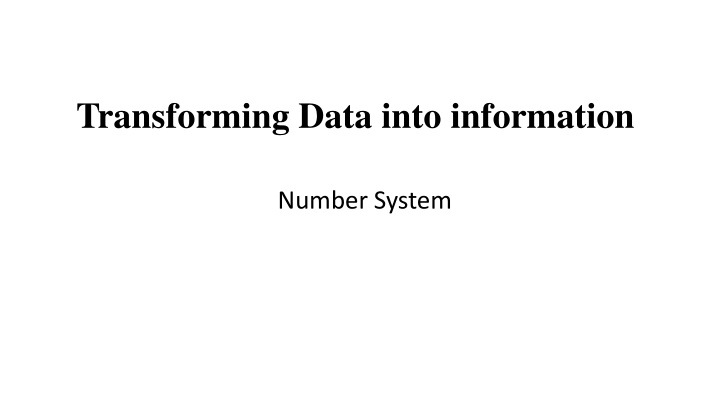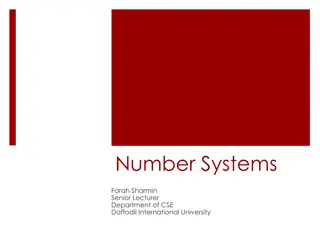
Number Systems in Computing
Explore how computers represent data using number systems, including binary, decimal, octal, and hexadecimal. Learn about the key characteristics of each system and how they are utilized in computer programming and everyday applications.
Download Presentation

Please find below an Image/Link to download the presentation.
The content on the website is provided AS IS for your information and personal use only. It may not be sold, licensed, or shared on other websites without obtaining consent from the author. If you encounter any issues during the download, it is possible that the publisher has removed the file from their server.
You are allowed to download the files provided on this website for personal or commercial use, subject to the condition that they are used lawfully. All files are the property of their respective owners.
The content on the website is provided AS IS for your information and personal use only. It may not be sold, licensed, or shared on other websites without obtaining consent from the author.
E N D
Presentation Transcript
Transforming Data into information Number System
How computer represent Data Number systems Bit and Bytes
Number Systems Number Systems To a computer everything is a number. Numbers are numbers, letters and punctuation are numbers sounds and picture are number. Even the computer own instruction are number. All computer data is converted to a series of binary numbers 1 and 0.For example you see a sentence of collection of letters but the computer sees each letter as a collection of 1 and 0.
Number Systems Here are some words
Number Systems Number Systems There have the four number systems. They are Binary number systems Decimal number systems Octal number systems Hexadecimal number systems
Binary Number systems Key characteristics of Binary Number systems Binary numbers are represented by only two symbols or digits, i.e. 0 (zero) and 1(one) The maximum value is 1 The base of this number is 2 Binary Number systems is used in computer
Decimal number systems Key characteristics of Decimal number systems The decimal system consists single-digit numbers: 0, 1, 2, 3, 4, 5, 6, 7, 8 and 9 The maximum value is 9 Anumber with base 10 Used in everyday arithmetic, financial calculation
Octal number systems Key characteristics of Decimal number systems It uses digits 0 to 7 Maximum value is 7 The base of octal number is 8 With each octal digit corresponding to three binary bits, it offers a concise and human-readable format
Hexadecimal number systems Key characteristics of Hexadecimal number systems In this system there are 16 symbols or possible digit values from 0 to 9, followed by six alphabetic characters --A, B, C, D, E and F Maximum values is 15 Base is 16
It can be used to represent large numbers with fewer digits, display error messages, d fine colores on web pages. Hexad cimal use HTML to code the system. For exemple: #FF5733 represents a shade of orange, where FF is the red component, 57 is the green component, and 33 is the blue component.
Conversion Binary to Decimal Step 1: Multiply each digit starting from the rightmost digit by the powers of 2. Here, we start with 20and increase the exponent by 1 as we move onto the left side. Step 2: Repeat step 2 until all the digits have been multiplied Step 3: Finally, sum up all the products
Example Example (10111)2 = ( .)10 =1*24+ 0*23+ 1*22+ 1*21+ 1*20 =16+0+4+2+1 = 23 (10111)2 = (23)10 (111001)2=( .)10
Hexadecimal 0 1 2 3 4 5 6 7 8 9 A B C D E F Decimal 0 1 2 3 4 5 6 7 8 9 10 11 12 13 14 15 Binary 0 1 10 11 100 101 110 111 1000 1001 1010 1011 1100 1101 1110 1111
Binary to Octal Divide the binary digit into group of three starting from right (1101011)2= ( ..)8 001 101 011
Binary to octal (Fraction value) (.01110)2= ( ..)8 (11010101. 0111110)2= ( ..)8
Binary to Hexadecimal Take binary number Divide the binary digits into groups of four (starting from right) for integer part and start from left for fraction part. Convert each group of four binary digits to one hexadecimal digit
Example (1010101101001)2= ( ..)16 (10101010101.0110110101110)2= ( ..)16
Decimal to binary There have some steps to convert decimal to binary 1. Divide the decimal number by 2 and note the remainder 2. Divide the quotient you got from the previous division once again by 2 and note the remainder 3. Repeat the steps 2 until the quotient becomes 0 4. Obtain remainder from bottom to top
Example Example 1. (42)10= ( ..)2 2. (75)10= ( ..)2 3. (47.25)10=( .)2
Decimal to Octal There have some steps to convert decimal to binary 1. Divide the decimal number by 8 and note the remainder 2. Divide the quotient you got from the previous division once again by 8 and note the remainder 3. Repeat the steps 2 until the quotient becomes 0 4. Obtain remainder from bottom to top
Example 1. (42)10=( ..)8 2. (56.60)10=( ...)8
Decimal to hexadecimal Decimal to hexadecimal There have some steps to convert decimal to binary 1. Divide the decimal number by 16 and note the remainder 2. Divide the quotient you got from the previous division once again by 16 and note the remainder 3. Repeat the steps 2 until the quotient becomes 0 4. Obtain remainder from bottom to top
Example 1. (62)10=( ..)16 2. (90.74)10=( ..)16
Octal to Binary 1. (45)8= ( .)2 2. (71.65)8= ( .)2
Octal to Decimal 1.(63)8= ( .)10 2.(26.75)8= ( .)10
Octal to Hexadecimal 1.(250)8= ( .)16 2.(145.372)8= ( .)16
Hexadecimal to binary 1.(3B)16= ( .)2 2.(DB.16)16= ( .)2
Hexadecimal to Decimal 1. (3E.4A)16= ( .)10
Hexadecimal to Octal 1. (E7)16= ( .)8 2. (B9.8C)16= ( .)8
Bits and Bytes What is a Bit? A bit (binary digit) is the smallest unit of data that a computer can process and store. The state is represented by a single binary value, usually a 0 or 1. However, the state might also be represented by yes/no, on/off or true/false. Example: 0,1 What is Bytes? Byte is made of 8 bits. It is used in determining the system storage. Byte is the most common term used in computing. It is used to represent 2^8 = 256 different values. Example: 01000001
Difference between bits and bytes Bit Byte It can be understood as a collection of Bits. It is quite greater. It is the smallest unit of data It is represented in 256 different types. It is also consist of additional special character. It is represented either in form 0 or 1. It is represented by the symbol b in lower case It is represented by the symbol B in upper case. Example: Used in radio,telecommunication,data speed, voltage. Example: Used in data file storage,Movies,images etc.
Kilobytes usually measures the size of text documents, graphics of websites, individual files. Megabytes usually measure the size of large files. For example high-resolution images, songs, storage of compact disks, etc. Gigabytes measure the capacity of storage devices. Terabytes usually measure the capacity of large storage devices, for example, HDDs (Hard Disk Drives). Petabytes usually measure the total data storage in large networks or server farms. For example, the data in Google or Facebook data servers is around more than 10 PBs






















